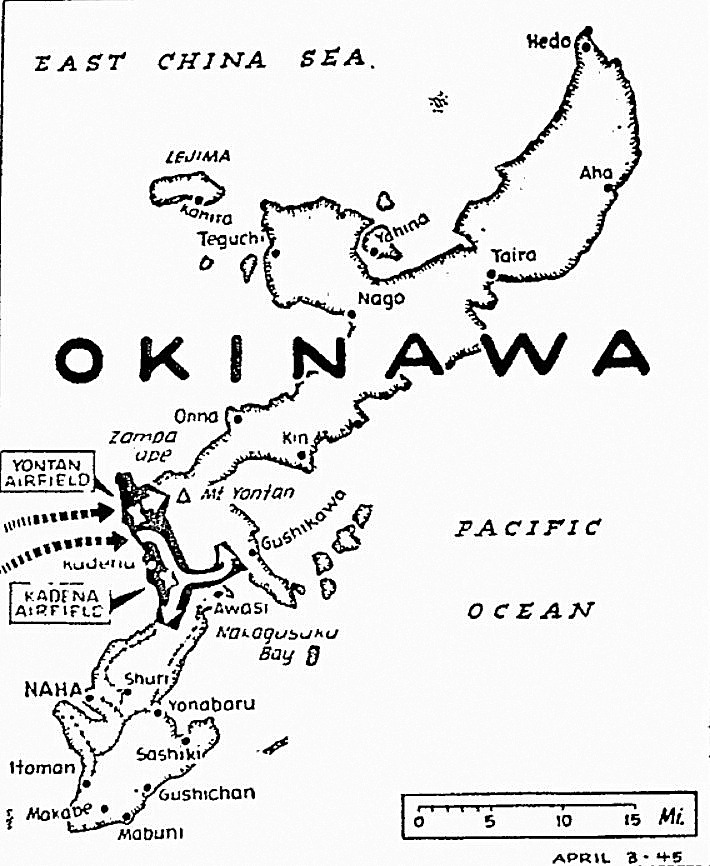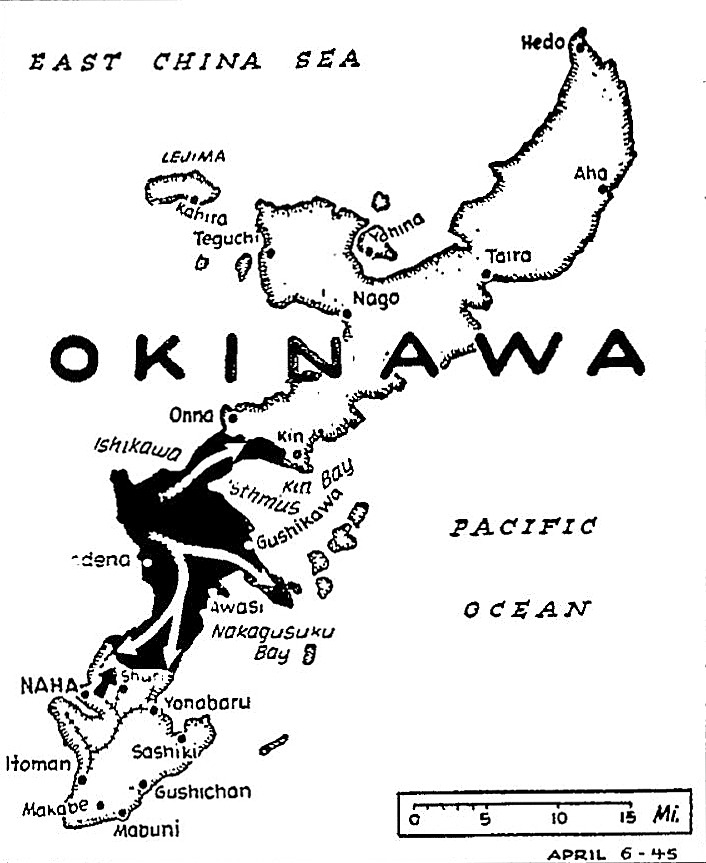Okinawa called Easter gift – landing like rehearsal
Gunboats touch off swooshing barrages of rockets in support of new Pacific invasion
By William McGaffin
WITH THE U.S. TENTH ARMY ON OKINAWA (April 1, delayed) – A mighty new army of Marines and soldiers went to church ion their transports 13 hours earlier than folks on Fifth Avenue this beautiful Easter Sunday. Then they walked ashore on Okinawa Island in an almost unopposed landing.
It was virtually a bloodless beachhead they established on this strategically vital island. Not since Kiska have we had such an easy time.
I watched the landing through glasses from the bridge of an amphibious flagship. This afternoon I followed the troops ashore and walked over the major part of the Marine beachhead with gray-haired Maj. Gen. Roy S. Geiger, commanding general of the Marine III Amphibious Corps troops, who comprise half of the Tenth Army.
Asks about casualties
At every command post we visited on this picturesque pine tree-clad island, the 60-year-old general inquired about casualties and everywhere the answer was a fantastically low figure. There were, for example, only 10 wounded and one killed in one Marine regiment up to two this afternoon, according to Lt. Col. Fred Beans of Cleburne, Texas, who is the executive officer of the regiment.
“I’ve seen only six dead Japs,” the colonel added.
Casualties were described as “exceedingly light,” too, with the XXIV Army Corps making up the rest of the Tenth Army.
Some called it an Easter present, other dubbed it “April Fool.” The general commented: “Doggone. I never, never have been on a battlefield like this before. It’s just a rehearsal. only more fun.”
1,500 planes attack
This is officially credited with being the “largest amphibious operation of the war in the Pacific to date.” More than 1,400 ships are involved and 1,500 carrier-based planes are providing close support.
It was exhilarating to watch the battleships slamming away at point blank range in the grand climax to a solid week of preparatory naval bombardment, to see the gunboats touch off swooshing barrages of rockets, to see flight after flight of planes thunder in to bomb and strafe and rocket.
After this, landing-boats paraded by with flags flying and started toward shore with their precious human cargoes. Half a mile from shore they surmounted a nasty reef and kept on going. At 0846 (8:46 a.m.) they hit the beach.
A clean beach
No landing craft were lost to enemy action on the half of the beach I visited ana no mines were found. It was a clean beach with no bodies, no damaged equipment, no crowded first-aid stations.
It was such a strange looking beachhead it didn’t seem as though we could be landing on hostile territory.
One Marine said: “It looks just like Jones Beach (on Long Island) on a Sunday afternoon.”
We control the sea and air. There is no sight of enemy fleet. Our planes have had a field day over the target, with no ack-ack opposing them. The weather, which worried us on our way here, was perfect today – cool, with a bright sun and a smooth sea.
Troops walk upright
The troops walked upright after they landed and made excellent progress. They captured two airfields before the end of the morning.
It is believed that there were anywhere from 60,000 to 80,000 enemy troops here. If that is true, we cannot understand why they didn’t oppose our landing more vigorously. The only living things we encountered were civilians. They were friendly and bowed low to the Marines who then led them to reception camps.
The general expressed himself as mystified by the Jap conduct. It is quite possible that there will be some bloody struggles yet. But we got artillery and tanks ashore today. And by letting us take two airfields the Japs simply gave us Okinawa.

